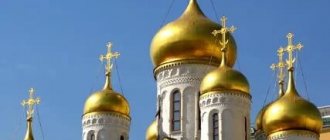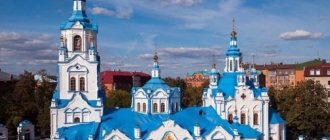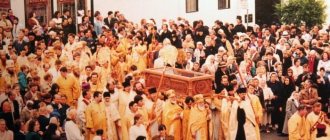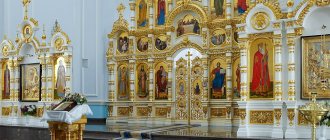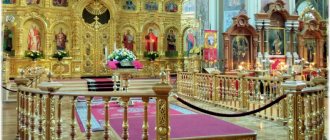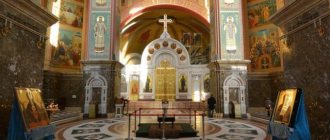This term has other meanings, see Council.
Notre Dame Cathedral
Cathedral
- the main church of a city or monastery, in which the service is led by a bishop (archbishop, metropolitan, patriarch).
Russian term for cathedral
in Western European languages the English terms correspond.
cathedral, fr. cathedrale, German Kathedrale, Italian. cattedrale, Spanish catedral
, coming from the word
department
.
Thus, they indicate that we are talking about a cathedral church, in Russian more often referred to as a “cathedral”. Another term for such a church in German is house,
from the Latin
domus ecclesiae
or
domus episcopalis
;
also Italian duomo
, Dutch
Domkerk
and cognates in many other European languages.
Cathedral churches are usually characteristic of Christian denominations with an episcopal hierarchy, such as the Orthodox, Catholic, Anglican, and some Lutheran and Methodist churches. In Greek Orthodox churches, the word cathedral is usually translated as καθολικόν
, meaning "main, common temple";
but this name is also applied to monastic and other large churches, including those without the status of an episcopal see. For a church that serves as the see of an archbishop or metropolitan, the term καθεδρικός ναός
, meaning "cathedral church".
Church buildings embodying the functions of a cathedral first appear in Italy, Gaul, Spain and North Africa in the 4th century, but they were not universal in the Western Church until the 12th century, by which time specific architectural forms, institutional structures and legal frameworks had already been developed. identity, which clearly separated cathedral churches from parish churches, monastic churches and episcopal residences. After the Reformation, the Christian Church in several parts of Western Europe, such as Scotland, the Netherlands, some Swiss cantons and parts of Germany, adopted the Presbyterian polity, which completely did away with the power of bishops. Where ancient cathedral buildings in these lands were still used for communal worship, they tended to retain the title and dignity of "cathedral", retaining and developing the distinct functions of the cathedral, but lacking hierarchical superiority. From the 16th century onwards, but especially from the 19th century, churches originating in Western Europe carried out active missionary programs, leading to the creation of a large number of new dioceses with associated cathedrals of various forms in Asia, Africa, Australasia, Oceania and Northern and South America. In addition, both the Catholic and Orthodox churches formed new dioceses for converts and fellow believers who were migrants. Consequently, in one city one can often find more than one cathedral of different denominations.
Status value
Assumption Cathedral in Helsinki
In Orthodoxy, the status of a cathedral is also assigned to the main church of the city, monastery, and churches of special importance in the capitals[1].
Both in Orthodoxy and Catholicism, the status of a cathedral is assigned to a temple once and for all. The ruling bishop may build or choose another church to locate his cathedral. Then the new church is given the status of a cathedral; the former cathedral also retains the name of the cathedral (although it does not have an episcopal see). In Moscow, for example, cathedrals
the names of the former patriarchal cathedrals are: Assumption, Archangel and Annunciation in the Kremlin, Intercession (St. Basil's) on Red Square, built by Ivan the Terrible to commemorate the capture of Kazan, Epiphany (Elokhovsky), etc. The cathedrals
are
[2] Epiphany and the Cathedral of Christ the Savior .
The size of the cathedral may not differ from an ordinary parish church, but it is designed so that divine services (mainly holiday ones) are performed by the cathedral
clergy, that is, there are
several
priests on the temple staff (ideally, the rector and 12 priests serving him, in the image of Christ and the twelve apostles). In reality, there are numerous clergy only in the main churches of the diocese (for example, with the title “Metropolitan of Smolensk and Kaliningrad,” the cathedrals should be in Smolensk and Kaliningrad), where the bishop’s see is located. In Catholic cathedrals, Holy Mass is often celebrated by a single priest, even on holidays.
The term cathedral has nothing to do with the size and decoration of the building. However, most cathedrals are quite impressive buildings. Thus, the term cathedral, cathedral or cathedral is often applied colloquially to any large and impressive church, whether or not it functions as a cathedral.
Cathedral of the second
A diocesan city may be quite small in size, rarely visited by the bishop (which together does not make it necessary to constantly have a pulpit in the center of the church) with a small staff of priests (two or three).
In a monastery (mainly in a monastery, where monks often have holy orders, especially those occupying key positions - dean, ecclesiarch, sacristan, etc.), as a rule, there is always a cathedral church called the catholicon.
What is a "cathedral"
Cathedrals are divided into monastic and cathedral. The cathedral is the name given to the church where the seat of the current bishop is located. Many clergy representatives gather in such a place. In the main churches there is a cathedra, that is, a platform where the bishop conducts services.
The emergence of cathedrals
In the early church, bishops did not sit leading worship, but instead presided while standing on a dais or pulpit (cathedra). In the third century, the expression "ad pulpitum venire" became the standard term for Christian ordination. During the siege of Dura Europos in 256, the complete Christian house church, or domus ecclesiae, was buried under the defensive rampart and, when excavated, was preserved in places to the height of the top of the wall. The church of this city was converted from a large city courtyard house of a standard form, in which two rooms were connected to form an assembly hall capable of accommodating 60-75 people; while in a room on the opposite side of the courtyard a tank was installed as a baptistery, over which hung rich wall paintings. In the great hall a raised pulpit was indeed discovered, large enough for one man in turn to read, preach, and preside; but too low to be crowned with a throne, and too small to contain an altar. Otherwise, the large room had no decoration or distinguishing features at all.
In 269, shortly after Dura-Europos fell to the Persian army, a group of clerics collected an indictment against the Bishop of Antioch, Paul of Samosata, in the form of an open letter. Among the charges were that Paul, who had received the civil rank of ducenarius through his connections at the imperial court, had improperly erected for himself a fence, or secretum, in the Church of Antioch; that within this enclosure he erected a throne from which he presided over the divine service; and that he trained a women's choir to sing hymns of his own composition. All these practices were condemned as innovations that introduced the symbols of his secular Roman magistracy into ecclesiastical ritual; at the same time, arrogantly and blasphemously asserting that the person of the bishop in the Eucharistic service sits in the place of Christ himself. And yet, within a hundred years, all the bishops in the Mediterranean world had cathedrals, all sat on thrones in the enclosed space of the sanctuary, and all created trained choirs to enhance the Eucharistic celebration.
The driving principle underlying this change was the acceptance by the bishops, more or less willingly, of the imperial invitation to accept and maintain the duties, dignity and insignia of a state magistrate. The Roman magistrate presided from an elevated throne in a large, ornate rectangular hall with aisles called a basilica; and now the bishops were doing the same. The earliest of these new Basilican cathedrals, significant remains of which are still visible (and perhaps one of the earliest to be built), lies below the Cathedral of Aquileia on the northern tip of the Adriatic Sea. Dating from a mosaic inscription to between 313 and 319, the complex consisted of two parallel halls with east and west aisles of equal size; with a third smaller north-south transverse hall connecting the two, which has been interpreted as the hall of the episcopal administration (episcopium) or bishop's residence. Three halls create an open courtyard, which originally housed a separate baptistery. Both large basilica halls retain rich mosaic pavements showing (among other scenes) Jonah and Whale, as well as a series of mostly female portraits of the donors. It appears that similar cathedrals, double basilica and baptistery, were soon erected at Milan, Trier and Pavia; but subsequently single-basilica churches became the more common cathedral model.
Constantine's declaration of the emperor's favor towards Christianity changed every aspect of Christian life in the Roman Empire. As a minority religion, largely confined to urban areas and limited social groups and subject to official hostility and occasional persecution, Christianity gained a significantly larger number of potential adherents from among all classes, initially in urban areas, but eventually spread to pag, rural areas, dependent from the city. The consequence was a radical expansion of the buildings, funding and personnel of associated ecclesiastical institutions throughout the 4th century.
Councils in different directions of Christianity
The three main directions of Christianity are Orthodoxy, Catholicism and Protestantism. Historically, these directions differ both in interpretation and views, and in the construction of churches.
Orthodoxy
The Orthodox church has three parts:
- Altar;
- Naos (or middle part under the dome);
- Narthex (entrance inside).
At the same time, in Orthodox churches the altar is covered with an iconostasis. Also one of the main differences is the architectural shape of the domes. If Catholics built buildings in the Gothic style, then Orthodox churches and temples have light colors and rounded domes.
Catholicism
As mentioned above, Catholic churches are built in the Gothic style, that is, they are large in scale, built of dark stone, great detail, sharp towers stretch upward, giving an intimidating appearance. During construction, Catholics tried to emphasize how God rises above people. There are also benches inside and parishioners listen to the service while sitting.
Protestantism
The architecture of Protestant buildings is dominated by minimalism and laconicism. Their interesting feature is that local culture can be woven into this style. For example, in the east, a Protestant church can be made in the form of a mosque, in the Baltics it can be built in the form of a wooden frame.
Peculiarities
Orthodoxy
St. Basil's Cathedral
Along with the building where the current bishop's cathedra is located, cathedrals are the names of the buildings where this cathedra has ever been.
In addition, the main church of the monastery (katholikon in modern Greece) is called the cathedral. It should be noted that the monastery cathedral may be the main church of the diocese.
During the synodal period in the history of the Russian Church, the cathedral could, in addition, designate the main temple of the department, in which the protopresbyter of the military, naval or court clergy performed services, and regimental cathedrals were created in regiments with a long history. In large cities, each of the administrative parts had its own cathedral[3].
For example, in St. Petersburg, in addition to the main cathedral
Cathedral of the city, there were cathedrals of the main parts of the city, as well as two court cathedrals, two naval cathedrals, four military cathedrals, the cathedral of all educational institutions, as well as two
memorial
cathedrals: Sampsonievsky and “Savior on Spilled Blood”.
The tradition of constructing memorial cathedrals (cathedral-monuments) dates back to Ancient Rus'. In particular, such a cathedral-monument was the famous Cathedral of the Intercession on the Moat
(better known as St. Basil's Cathedral)[3], located in Moscow on Red Square.
Catholicism
Strasbourg Cathedral
In the Catholic tradition, the term cathedral (“cathedral”) applies only to the church in which the seat of the diocesan bishop is located. The abbey church of a territorial abbey performs the same function (that is, it houses the residence of the abbot), but does not acquire a title. In any other jurisdiction canonically equivalent to a diocese, but not elevated to the status of such (prelature, vicariate, ordinariate, prefecture, apostolic administration), the temple that performs this function is correctly called the “principal church” of the corresponding entity, although some they still used the term “cathedral”. The Catholic Church also uses the following terms:
- Pro-cathedral
. This word denotes a church temporarily used as a cathedral, usually while the cathedral church of the diocese is under construction, reconstruction or repair. This designation applies only as long as the temporary use continues. - The co-cathedral
is the second cathedral church in the diocese, which has two cathedrals. This situation can arise for various reasons: the merger of two former dioceses, preparations for the division of the diocese, or the perceived need to perform cathedral functions in a second place due to the vastness of the diocesan territory. - Proto-cathedral
is a former cathedral church after it lost its cathedral status.
Protestantism
Lincoln Cathedral
For Protestants (Anglicans, Lutherans), the cathedral is always the temple where the bishop's chair is or was. However, recently the name "cathedral" is sometimes used metaphorically - for example, the Arctic Cathedral (the parish church in Tromsø) or the Crystal Cathedral (the megachurch of the Presbyterians, who never had an episcopate).
How is a cathedral different from a church?
The word “church” comes from the Greek language and means “house of the Lord.” The church has an altar and a prayer room - a meal.
According to another version, the status of a church is assigned based on the number of chapels, that is, domes with a cross. A temple can have up to thirteen of them, while a church has only one. And usually in such churches only one priest conducts the liturgy.
To summarize, the main difference between a cathedral and a church is the presence of a bishop's chair and the focus on a large number of clergy.
The most famous cathedrals
| This section may contain original research. Add links to sources, otherwise it may be deleted. More information may be on the talk page. (2020-06-26) |
In Orthodoxy
- Annunciation Cathedral (Voronezh)
- Annunciation Cathedral (Athens, Greece)
- St. Vladimir's Cathedral (Kyiv, Ukraine)
- Demetrius Cathedral (Vladimir, Russia)
- St. Isaac's Cathedral (St. Petersburg, Russia)
- Kazan Cathedral (St. Petersburg, Russia)
- Peter and Paul Cathedral (St. Petersburg, Russia)
- St. Nicholas Cathedral (Bialystok, Poland)
- Smolny Cathedral (St. Petersburg, Russia)
- Savior on Spilled Blood (St. Petersburg, Russia)
- Cathedral of St. Sava (Belgrade, Serbia)
- St. Sophia Cathedral (Kyiv, Ukraine)
- St. Sophia Cathedral (Veliky Novgorod, Russia)
- St. Sophia Cathedral (Vologda, Russia)
- St. Sophia Cathedral (Polotsk, Belarus)
- Trinity Cathedral (Tbilisi, Georgia)
- Assumption Cathedral of the Moscow Kremlin (Moscow, Russia)
- Assumption Cathedral (Vladimir, Russia)
- Assumption Cathedral (Smolensk, Russia)
- Assumption Cathedral (Tbilisi, Georgia)
- Intercession Cathedral (St. Basil's Cathedral) (Moscow, Russia)
- Cathedral of Christ the Savior (Moscow, Russia)
In Catholicism
- Lateran Cathedral (Rome, Italy)
- St. Peter's Basilica (Vatican)
- Cathedral of Santa Maria del Fiore (Florence, Italy)
- St. Mark's Basilica (Venice, Italy)
- Milan Cathedral (Milan, Italy)
- Cologne Cathedral (Cologne, Germany)
- Königsberg Cathedral (Cathedral in Kaliningrad, Russia)
- Frankfurt Cathedral (Frankfurt, Germany)
- Speyer Cathedral (Speyer, Germany)
- Notre Dame Cathedral (Paris, France)
- Strasbourg Cathedral (Strasbourg, France)
- Rouen Cathedral (Rouen, France)
- Amiens Cathedral (Amiens, France)
- Reims Cathedral (Reims, France)
- Cathedral of St. Francis Xavier (Grodno, Belarus)
- Cathedral of Our Lady of Antwerp (Antwerp, Belgium)
- Salisbury Cathedral (Salisbury, England)
- St. Vitus Cathedral (Prague, Czech Republic)
- Cathedral of St. Stanislava (Vilnius, Lithuania)
- Latin Cathedral (Lviv, Ukraine)
- Archcathedral of the Blessed Virgin Mary (Minsk, Belarus)
- Cathedral of the Immaculate Conception of the Blessed Virgin Mary (Moscow, Russia)
In Protestantism
- St. Nicholas Cathedral (Helsinki, Finland)
- Minster Cathedral (York, UK)
- Berlin Cathedral (Berlin, Germany)
- Dome Cathedral (Riga, Latvia)
- Dome Cathedral (Tallinn, Estonia)
- Ulm Cathedral (Ulm, Germany)
Originated before the division of churches
- St. Peter's Basilica in Rome
- St. Sophia Cathedral in Constantinople
- St. Sophia Cathedral in Kyiv
- St. Sophia Cathedral in Veliky Novgorod
Ecumenical Council
Several Ecumenical Councils are dedicated to the remembrance of the Ecumenical Councils. days of the liturgical year. Close to modern the system of celebrated memories of the Ecumenical Councils is already present in the Typikon of the Great Church. IX-X centuries The hymnographic sequences of these days have many common readings and chants
In the Typikon of the Great Church. there are 5 commemorations of the Ecumenical Councils, which have a hymnographic sequence: in the 7th week (Sunday) of Easter - I-VI Ecumenical Councils (Mateos. Typicon. T. 2. P. 130-132); September 9 - III Ecumenical Council (Ibid. T. 1. P. 22); September 15 - VI Ecumenical Council (Ibid. P. 34-36); October 11 - VII Ecumenical Council (Ibid. T. 1. P. 66); July 16 - IV Ecumenical Council (Ibid. T. 1. P. 340-342). Associated with the latter memory is the memory of the Council of 536 against Sevier of Antioch in the week after July 16th. In addition, the Typikon marks 4 more commemorations of Ecumenical Councils, which do not have a special sequence: May 29 - the First Ecumenical Council; August 3 - II Ecumenical Council; July 11 - IV Ecumenical Council (together with the memory of the Great Martyr Euphemia); July 25 - V Ecumenical Council.
Ecumenical Councils. Fragment of the icon “Wisdom created a home for herself.” Novgorod. 1st half XVI century (Tretyakov Gallery) Ecumenical Councils. Fragment of the icon “Wisdom created a home for herself.” Novgorod. 1st half XVI century (TG)
In the Studite Synaxar, compared with the Typikon of the Great Church. the number of commemorations of the Ecumenical Councils was reduced. According to the Studian-Alexievsky Typikon of 1034, the memory of the Ecumenical Councils is celebrated 3 times a year: on the 7th week after Easter - 6 Ecumenical Councils (Pentkovsky. Typikon. pp. 271-272), October 11 - VII Ecumenical Council (together with the memory of St. Theophan the hymn-writer - Ibid., p. 289); in the week after July 11 - the IV Ecumenical Council (at the same time, instructions are given on commemorating the Council in the week before or after July 16 - Ibid. pp. 353-354). In the studio Typicons of other editions - Asia Minor and Athos-Italian XI-XII centuries, as well as in the early Jerusalem Typicons, the memory of the Ecumenical Councils is celebrated 1 or 2 times a year: in all Typicons the memory of the Ecumenical Councils is indicated on the 7th week after Easter ( Dmitrievsky. Description. T. 1. P. 588-589; Arranz. Typicon. P. 274-275; Kekelidze. Liturgical cargo monuments. P. 301), in some southern Italian and Athos monuments the memory of the IV Ecumenical Council is also noted in July (Kekelidze. Liturgical cargo monuments. P. 267; Dmitrievsky. Description. T. 1. P. 860).
In later editions of the Jerusalem Charter, a system of 3 commemorations was formed: on the 7th week of Easter, in October and in July. In this form, the memory of the Ecumenical Councils is celebrated according to modern times. printed Typikon.
Commemoration of the 6 Ecumenical Councils on the 7th week of Easter. According to the Typikon of the Great Church, on the day of remembrance of 6 V.S. a festive service is performed. On Saturday at Vespers, 3 proverbs are read: Gen 14. 14-20, Deut. 1. 8-17, Deut. 10. 14-21. At the end of Vespers, the troparion of the plagal 4th, i.e., 8th, tone is sung with the verses of Ps 43: ( ). After Vespers, pannikhis (παννυχίς) is performed. At Matins on Ps 50, 2 troparions are sung: the same as at Vespers, and the 4th tone ῾Ο Θεὸς τῶν πατέρων ἡμῶν ( ). After Matins, the “proclamations of the holy councils” are read. At the liturgy readings: prokeimenon Dan 3.26, Acts 20.16-18a, 28-36, alleluia with a verse from Ps 43, John 17.1-13, communion - Ps 32.1.
In studio and Jerusalem Typicons of various editions, including modern ones. printed publications, the system of readings on the 7th week of Easter has not undergone significant changes compared to the Typikon of the Great Church. During the service, 3 hymnographic sequences are sung - Sunday, the post-feast of the Ascension of the Lord, St. fathers (in the Evergetid Typikon, the succession of the post-feast is only partially presented - the self-concord and troparion; at Matins, the Sunday canons and the Holy Fathers). According to the Studian-Alexievsky, Evergetidsky and all Jerusalem Typicons, figurative troparions are sung at the liturgy, Sunday troparia and troparions from the morning canon of St. fathers (canto 3 according to Studiysko-Alexievsky, 1st - according to the Evergetid Typikon); in the South Italian Typicons the singing of the blessed with troparions (from the canon) of St. is indicated. Fathers, then - daily antiphons, the chorus to the 3rd antiphon is the troparion of St. fathers ῾Υπερδεδοξασμένος εἶ ( ).
According to modern Greek parish Typicon (Βιολάκης. Τυπικόν. Σ. 85, 386-387), on the 7th week the memory of the First Ecumenical Council is celebrated; All-night vigil is not celebrated.
Commemoration of the Third Ecumenical Council, September 9. Indicated in the Typikon of the Great Church. with liturgical follow-up: on Ps 50 the troparion of the plagal 1st, i.e. 5th, voice: ῾Αγιωτέρα τῶν Χερουβίμ (The Most Holy of the Cherubim), heavy, i.e. 7th, voice: Χαῖρ ε, κεχαριτωμένη Θεοτόκε Παρθένε, λιμὴν καὶ προστασία (Rejoice, blessed Virgin Mary, refuge and intercession). At the liturgy: prokeimenon from Ps 31, Heb 9. 1-7, alleluia with the verse Ps 36, Lk 8. 16-21, involved in Proverbs 10. 7. This memory is not present in the Studio and Jerusalem Typicons.
Commemoration of the VI Ecumenical Council September 15 According to the Typikon of the Great Church, the following of St. fathers on this day includes: troparion ῾Ο Θεὸς τῶν πατέρων ἡμῶν ( ), readings at the liturgy: prokeimenon from Ps 31, Heb 13. 7-16, alleluia with the verse Ps 36, Mt 5. 14-19, involved Ps 32 .1 Before the Apostle at the liturgy, it is prescribed to read the oros of the VI Ecumenical Council.
This memory is absent in the Studite and Jerusalem statutes, but certain monuments indicate the reading of the oros of the VI Ecumenical Council in the week after the Feast of the Exaltation of the Cross on September 14. (Kekelidze. Liturgical cargo monuments. P. 329; Typikon. Venice, 1577. L. 13 vol.). In addition, in the manuscripts there is a description of a special rite “in the Chamber of Trullo”, which takes place on the eve of the Exaltation after Vespers and includes antiphons from the verses of Ps 104 and 110 and acclamations in honor of the bishop and the emperor, which may also be a trace of the celebration of the memory of the VI Ecumenical Council (Lingas A . Festal Cathedral Vespers in Late Byzantium // OCP. 1997. N 63. P. 436; Hannick Chr. Étude sur l'ἀκολουθία σματική // JÖB. 1970. Bd. 17. S. 247, 251).
Commemoration of the VII Ecumenical Council in October. In the Typikon of the Great Church. this memory is indicated on October 11, the sequence is not given, but the performance of a solemn service in the Great Church is indicated. with the singing of pannikhis after Vespers.
According to the Studian-Alexievsky Typikon, the memory of St. Fathers is celebrated on October 11, the observance of St. Fathers is connected with the following of St. Theophanes the hymn writer. At Matins, “God is the Lord” and troparia are sung. Some hymns are borrowed from the sequence of the week of the 1st Lent: troparion of the 2nd tone, kontakion of the 8th tone. According to the 3rd song of the canon, ipakoi are indicated. At the liturgy readings: prokeimenon from Ps 149, Heb 9. 1-7, alleluia with the verse Ps 43, Lk 8. 5-15. Slav's instructions. Studian Menaions correspond to the Studian-Aleksievsky Typikon (Gorsky, Nevostruev. Description. Dept. 3. Part 2. P. 18; Yagich. Service Minaions. P. 71-78).
In the Evergetian, South Italian, early Jerusalem Typicons of the October memory of the VII Ecumenical Council there is no. It again begins to be indicated in later editions of the Jerusalem Charter, among Mark’s chapters (Dmitrievsky. Description. T. 3. P. 174, 197, 274, 311, 340; Mansvetov I.D. Church Charter (typical). M., 1885. P. 411; Typikon. Venice, 1577. L. 102; Typikon. M., 1610. 3rd Markov chapter L. 14-16 volumes), after. the instructions of Mark's chapter are transferred to the months. The sequence for this day is completely different from that given in the Studios-Alexievsky Typikon and the Studite Menaions and in many ways repeats the sequence of the 7th week of Easter. The Sunday and St. feasts are united. fathers, like a connection with the following of the sixfold saint, with certain features: reading proverbs, singing the troparion of St. fathers according to “Now you let go.” The observance of the holy day is transferred to another day or to Compline. In the Moscow editions of the Jerusalem Typikon (from the 17th century to the present time) there is a noticeable tendency to increase the status of the memory of St. fathers by changing the ratio of the chants of Octoechos and St. fathers. At Vespers the same readings are read as according to the Typikon of the Great Church. Various readings at the liturgy are indicated: Greek. old printed Typikon - Titus 3. 8-15, Matthew 5. 14-19 (prokeimenon, alleluia and sacrament are not indicated - Τυπικόν. Venice, 1577. L. 17, 102); Moscow editions, early printed and modern: prokeimenon Dan 3.26, Heb 13.7-16, alleluia with the verse Ps 49, John 17.1-13, involved Ps 32.1 (Ustav. M., 1610. Markova ch. 3. L. 16 vol.; Typikon. [Vol. 1.] pp. 210-211).
In modern Greek parish Typikon (Βιολάκης. Τυπικὸν. Σ. 84-85) this memory is celebrated in the week after October 11, the all-night vigil is not celebrated. The service charter generally corresponds to that given in the Jerusalem Typicons. Readings at the liturgy - Titus 3. 8-15, Luke 8. 5-15.
Commemoration of the Ecumenical Councils in July. According to the Typikon of the Great Church, on July 16 the memory of the IV Ecumenical Council is celebrated, the observance includes troparia: at Vespers and Matins the 4th tone ῾Ο Θεὸς τῶν πατέρων ἡμῶν (), at the liturgy of the same tone Τῆς καθολ ικῆς ἐκκλησίας τὰ δόγματα (Conciliar Church dogma) . Readings at the liturgy: prokeimenon from Ps 149, Heb 13. 7-16, alleluia with the verse Ps 43, Mt 5. 14-19, communion Ps 32. 1. After the Trisagion, the oros of the IV Ecumenical Council is read.
According to the Studian-Alexievsky Typikon, the memory of the IV Ecumenical Council is celebrated in the week after July 11 - the memory of the Great Church. Euphemia - or on Sunday before or after July 16th. The Sunday services are united, St. fathers and daily saint, the succession of St. Fathers includes the troparion (the same as in the Typikon of the Great Church on the 16th): () and the canon. As a hymn to St. Fathers use stichera vmts. Euphemia (in modern books - stichera on “Glory” on the vespers stichera). At the liturgy readings: prokeimenon from Ps 149, Heb 13. 7-16, alleluia with the verse Ps 43, Mt 5. 14-19 (participant not indicated).
The further history of the July commemoration of the Ecumenical Councils is similar to that of October; it is absent from most Studite and early Jerusalem Typicons. In the Typikon of George Mtatsmindeli of the 11th century, reflecting the Athonite edition of the Studite Charter, the arrangement of the July commemorations of the Councils (see below) and their successions largely follow the Typikon of the Great Church. July 16 - commemoration of the IV Ecumenical Council, the sequence includes: 3 readings at Vespers, 2 troparions (as in the Typikon of the Great Church), at the liturgy a service of choice: as in the 7th week of Easter or as according to the Typikon of the Great Church. July 16.
In the Jerusalem Typicons, the charter for the July service in memory of the 6 Ecumenical Councils is described in Mark’s chapters, together with the October memory or separately from it; after these instructions were transferred to the months. According to the old printed Greek. Typikon (Τυπικόν. Venice, 1577. L. 55 vol., 121 vol.), on July 16 the memory of the 6 Ecumenical Councils is celebrated, the charter of the service is like that of a sixfold saint. At the liturgy, the service is the same as according to the Typikon of the Great Church. in the week after July 16 (Gospel - Matt. 5. 14-19, involved Ps. 111. 6b). In the Moscow printed editions of the Typikon it is indicated to commemorate 6 V.S. per week before or after July 16. The charter of the service and readings at Vespers and Liturgy - as well as for the October memory (Charter. M., 1610. L. 786 vol. - 788 vol.; Typikon. [Vol. 2.] pp. 714-716).
According to modern Greek parish Typikon (Βιολάκης. Τυπικόν. Σ. 85, 289-290), in the week before or after July 16 (July 13-19) the memory of the IV Ecumenical Council is celebrated. The service is performed in the same way as for October memory. At the liturgy, the Gospel is Matthew 5. 14-19.
Notes
Cathedral:
- Meanings in Wiktionary
- Media files on Wikimedia Commons
- Portal "Cathedrals"
- Complete Orthodox Theological Encyclopedic Dictionary, vol. 2. M.: Vozrozhdenie, 1992
- Moscow diocese (city) / Organizations / Patriarchia.ru (unspecified)
. Patriarchy.ru. Access date: September 30, 2016. - ↑ 12
Cathedral Archived copy from April 11, 2015 on the Wayback Machine (inaccessible link from 06/14/2016 [2085 days]) // Russian Humanitarian Encyclopedic Dictionary: In 3 volumes - M.: Humanit. ed. VLADOS center: Philol. fak. St. Petersburg state University, 2002.
First Council
There are only seven ecumenical councils (officially recognized).
The very first was organized in Nicaea - in 325 AD. That's what they call it - the First Council of Nicaea.
It was at this meeting that Emperor Constantine, who was not a Christian at that time (but changed paganism to faith in the One God only before his death, by being baptized) declared his identity as the head of the state church.
He also appointed Christianity as the main religion of Byzantium and the Eastern Roman Empire.
At the first Ecumenical Council the Creed was approved.
And this meeting also became epoch-making in the history of Christianity, when there was a break between the church and the Jewish faith.
Emperor Constantine established principles that reflected the attitude of Christians towards the Jewish people - this is contempt and separation from them.
After the first Ecumenical Council, the Christian Church began to submit to secular governance. At the same time, it lost its main values: the ability to give people spiritual life and joy, to be a saving force, to have a prophetic spirit and light.
In essence, the church was made into a “murderer,” a persecutor who persecuted and killed innocent people. It was a terrible time for Christianity.
Fourth Council
The event took place in the city of Chalcedon - in 451 (Chalcedonian). At that time, the ruler was Emperor Marcian - the son of a warrior by birth, but who won the glory of a brave soldier, who, by the will of the Almighty, became the head of the empire by marrying the daughter of Theodosius - Pulcheria.
About 630 bishops were present at the Fourth Ecumenical Council, among them: Patriarch of Jerusalem - Juvenaly, Patriarch of Constantinople - Anatoly and others. A clergyman also arrived - the envoy of Pope Leo.
There were also negative church representatives among the rest. For example, Patriarch Maximus of Antioch, whom Dioscorus sent, and Eutyches with like-minded people.
The following issues were discussed at this meeting:
- condemnation of the false teaching of the Monophysites, who claimed that Christ possessed an exclusively divine nature;
- decree that the Lord Jesus Christ is true God as well as true Man.
- about representatives of the Armenian Church, who in their vision of faith united with the religious movement - the Monophysites.
Seventh Council
Held in 787 in the city of Nicaea (or II Nicaea). The Seventh Ecumenical Council was convened by Empress Irina, who wanted to officially restore the right of Christians to venerate holy images (she herself secretly worshiped icons).
Irina accomplished this on the recommendation of Patriarch Tarasius, who became the chairman of the cathedral.
At an official international meeting, the heresy of iconoclasm was condemned (which allowed icons and faces of saints to be legally placed in churches next to the holy cross), and 22 canons were restored.
Thanks to the Seventh Ecumenical Council, it became possible to venerate and worship icons, but it is important to direct your mind and heart to the living Lord and Mother of God.
Third Council
This official Christian event of international scale took place in the summer, in 431, in the city of Ephesus (and therefore called Ephesus).
The Third Ecumenical Council took place under the leadership and with the permission of Emperor Theodosius the Younger.
The main topic of the meeting was the false teaching of Patriarch Nestorius of Constantinople. His vision was criticized that:
- Christ has two hypostases - divine (spiritual) and human (earthly), that the Son of God was born initially as a man, and then Divine power united with him.
- The Most Pure Mary must be called Christ Mother (instead of Theotokos).
With these bold assurances, Nestorius, in the eyes of other clergy, rebelled against the previously established opinions that Christ was born from the virgin birth and that he atoned for human sins with his life.
Even before the convening of the council, the Patriarch of Alexandria, Kirill, tried to reason with this obstinate Patriarch of Constantinople, but in vain.
About 200 clergy arrived at the Council of Ephesus, among them: Juvenal of Jerusalem, Cyril of Alexandria, Memon of Ephesus, representatives of St. Celestine (Pope of Rome) and others.
At the end of this international event, the heresy of Nestorius was condemned. This was clothed in the corresponding records - “12 anathematisms against Nestorius” and “8 rules”.
Bishops' councils
Another type of Local Council, at which issues of the activities of the Church in the localities are considered, can be the Council of Bishops. Only the highest hierarchs of the Church can take part in it.
Bishops' Council of the Russian Orthodox Church, 2022
The activities and powers of the Council of Bishops are prescribed in the Charter of the Russian Orthodox Church of 2000. So, according to this document, the Council of Bishops is characterized as:
- the highest body of church authority;
- meets at least once every 4 years and is chaired by His Holiness the Patriarch;
- performs the functions of a church court and considers internal contradictions arising in the Church.
The existence of the Church was laid down by the Lord Jesus Christ himself, therefore every Orthodox Christian must remember the need to visit the temple of God. The temple is a huge living organism whose activities are regulated by a large number of ordained clergy led by the Holy Spirit. The decisions taken at the Councils should not be criticized, but carried out with humility by all Orthodox Christians.
Fifth Council
The meeting took place in the city of Constantinople - in 553 (that is why the council was called II of Constantinople). The ruler at that time was the holy and blessed king Justinian I.
What was decided at the Fifth Ecumenical Council?
First of all, the orthodoxy of the bishops was examined, who during their lifetime reflected Nestorian thoughts in their works. This:
- Willow of Edessa;
- Theodore of Mopsuetsky;
- Theodoret of Cyrus.
Thus, the main topic of the council was the question “On the Three Chapters.”
Even at the international meeting, the bishops considered the teachings of Presbyter Origen (he once said that the soul lives before incarnation on earth), who lived in the 3rd century after the Nativity of Christ.
They also condemned heretics who did not agree with the opinion about the general resurrection of people.
165 bishops gathered here. The cathedral was opened by Eutyches, the Patriarch of Constantinople.
The Pope, Virgil, was invited to the meeting three times, but he refused to attend. And when the cathedral council threatened to sign a resolution to excommunicate him from the church, he agreed with the opinion of the majority and signed a conciliar document - an anathema regarding Theodore of Mopsuet, Iva and Theodoret.
Preparation of Pan-Orthodox Councils
In the 20th century, the Orthodox Church tried to prepare for the Eighth Ecumenical Council. This was planned in the 20s, 60s, 90s of the last century. And also in 2009 and 2016 of this century.
But, unfortunately, all attempts so far have ended in nothing. Although the Russian Orthodox Church is in a state of spiritual activity.
As follows from practical experience regarding this event of international scale, only the same one that will be subsequent can recognize the council as Ecumenical.
In 2016, it was planned to organize a Pan-Orthodox Council, which was to be held in Istanbul. But so far only a meeting of representatives of Orthodox churches has taken place there.
The planned eighth Ecumenical Council will be attended by 24 bishops - representatives of local churches.
The event will be held by the Patriarchate of Constantinople - in the Church of St. Irene.
The following topics are planned to be discussed at this council:
- the meaning of Fasting, its observance;
- obstacles to marriage;
- calendar;
- church autonomy;
- the relationship of the Orthodox Church to other Christian denominations;
- Orthodox faith and society.
This will be a significant event for all believers, as well as for the Christian world as a whole.
Recognition of cathedrals by the church
According to history, the Orthodox, Catholic and other Christian churches have formed their opinions regarding international level councils and their number.
Therefore, only two have official status: the first and second Ecumenical Councils. These are the ones recognized by all churches without exception. Including the Assyrian Church of the East.
The first three Ecumenical Councils are recognized by the Ancient Eastern Orthodox Church. And the Byzantine - all seven.
According to the Catholic Church, 21 world councils have taken place in 2 thousand years.
Which cathedrals are recognized by the Orthodox and Catholic churches?
- Far Eastern, Catholic and Orthodox (Jerusalem, I Nicaea and I Constantinople).
- Far Eastern (with the exception of Assyrian), Catholic and Orthodox (Cathedral of Ephesus).
- Orthodox and Catholic (Chalcedonian, II and III Constantinople, II Nicene).
- Catholic (IV Constantinople 869-870; I, II, III Lateran XII century, IV Lateran XIII century; I, II Lyons XIII century; Vienne 1311-1312; Constance 1414-1418; Ferraro-Florentine 1438- 1445; V Lateran 1512-1517; Trentine 1545-1563; I Vatican 1869-1870, II Vatican 1962-1965);
- Councils that were recognized by Ecumenical theologians and representatives of Orthodoxy (IV Constantinople 869-870; V Constantinople 1341-1351).
Sixth Council
This international meeting was preceded by history. The Byzantine government decided to annex the Monophysite movement to the Orthodox Church. This led to the emergence of a new movement - the Monothelites.
At the beginning of the 7th century, Heraclius was the emperor of the Byzantine Empire. He was against religious divisions, and therefore made every effort to unite everyone in one faith. He even intended to assemble a cathedral for this purpose. But the issue was not completely resolved.
When Constantine Pagonat ascended the throne, the division between Orthodox Christians and Monothelites again became noticeable. The emperor decided that Orthodoxy must triumph.
In 680, the sixth Ecumenical Council (also called III Constantinople or Trullo) was assembled in the city of Constantinople. And before that, Constantine deposed the Patriarch of Constantinople named Theodore, who belonged to the Monothelite movement. And instead he appointed Presbyter George, who supported the dogmas of the Orthodox Church.
A total of 170 bishops came to the Sixth Ecumenical Council. Including representatives of the Pope, Agathon.
Christian teaching supported the idea of two wills of Christ - divine and earthly (and the Monothelites had a different vision on this matter). This was approved at the council.
The meeting lasted until 681. There were 18 bishops' meetings in total.
